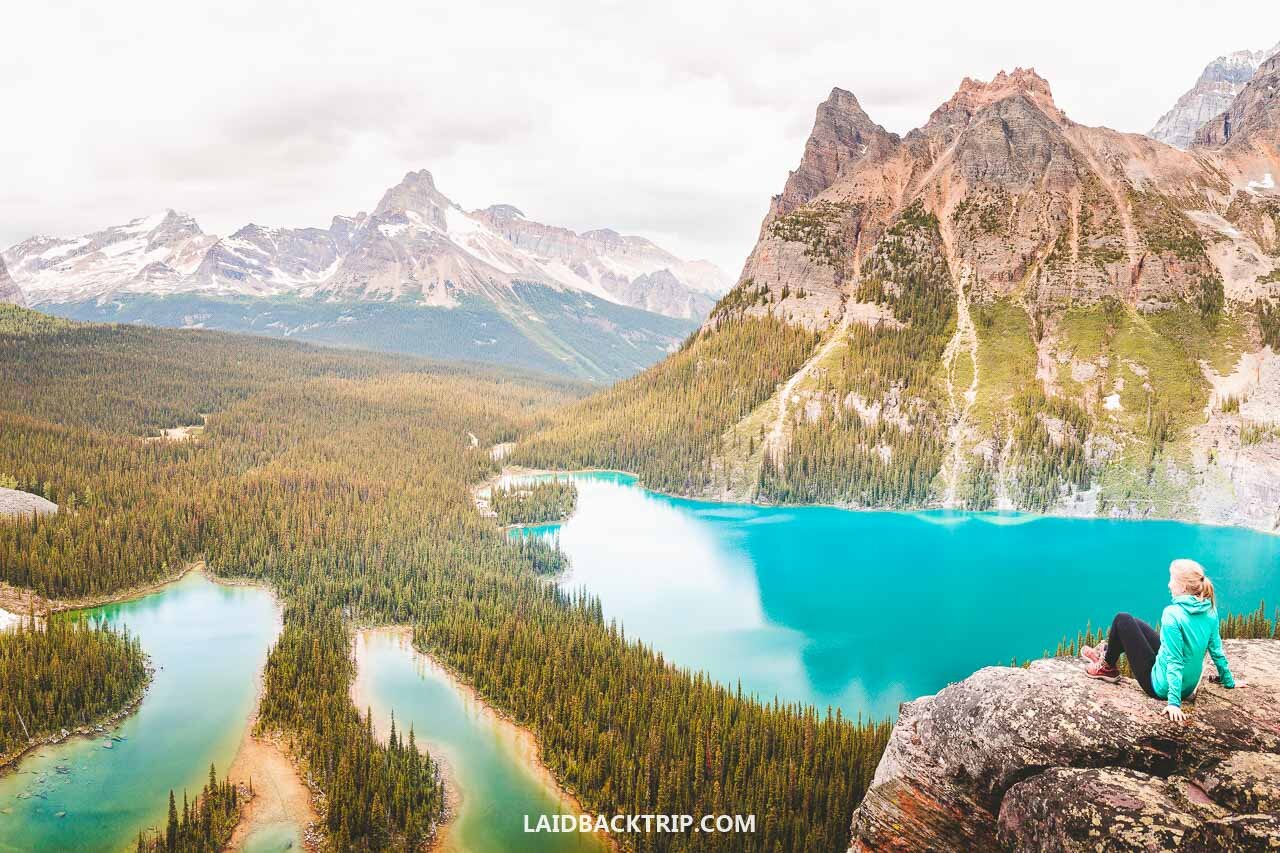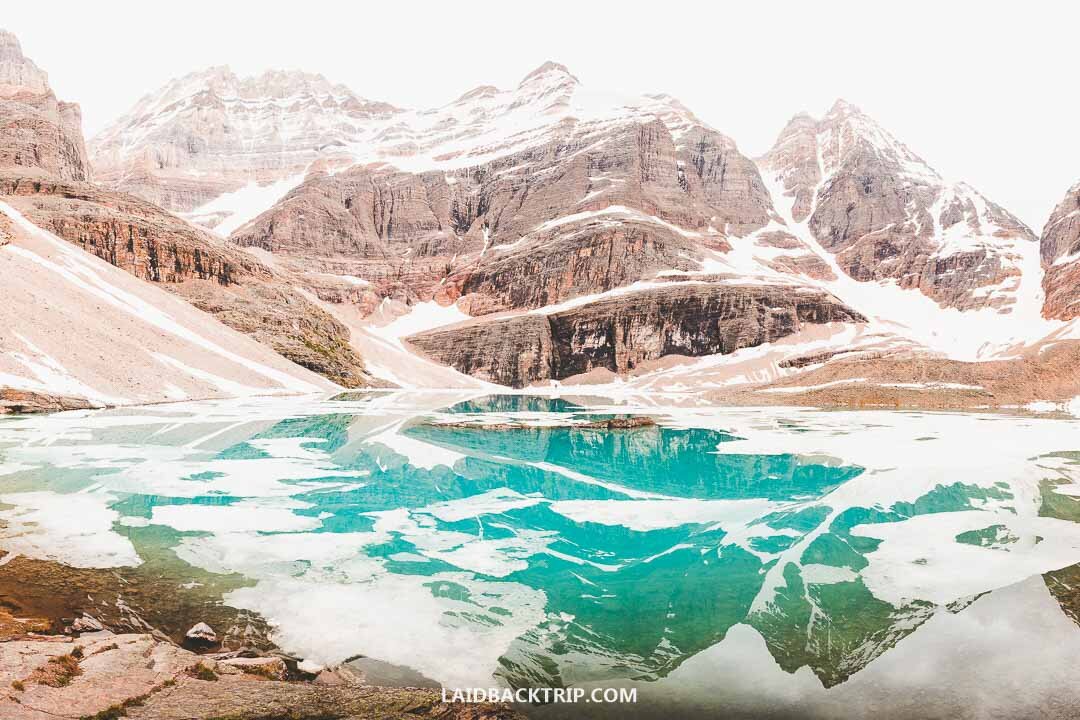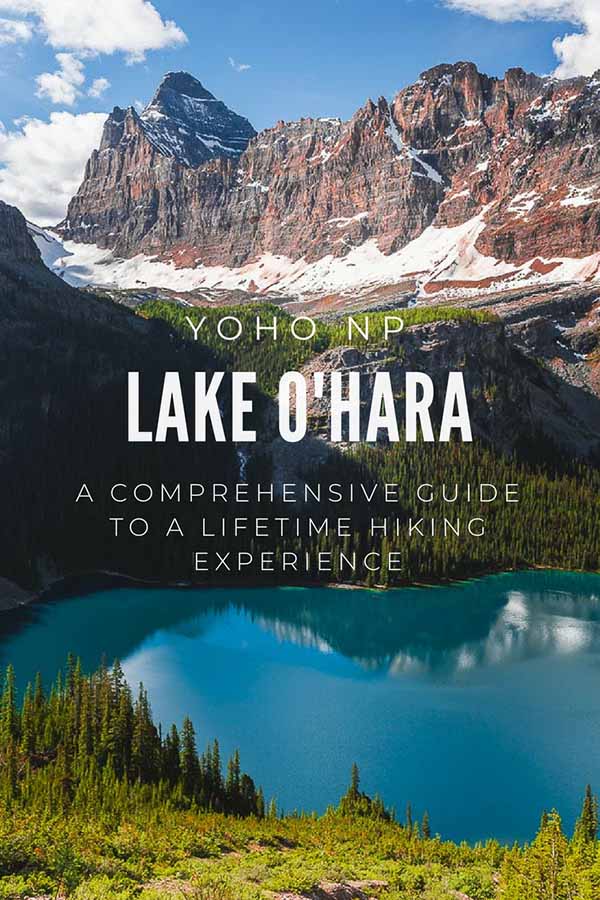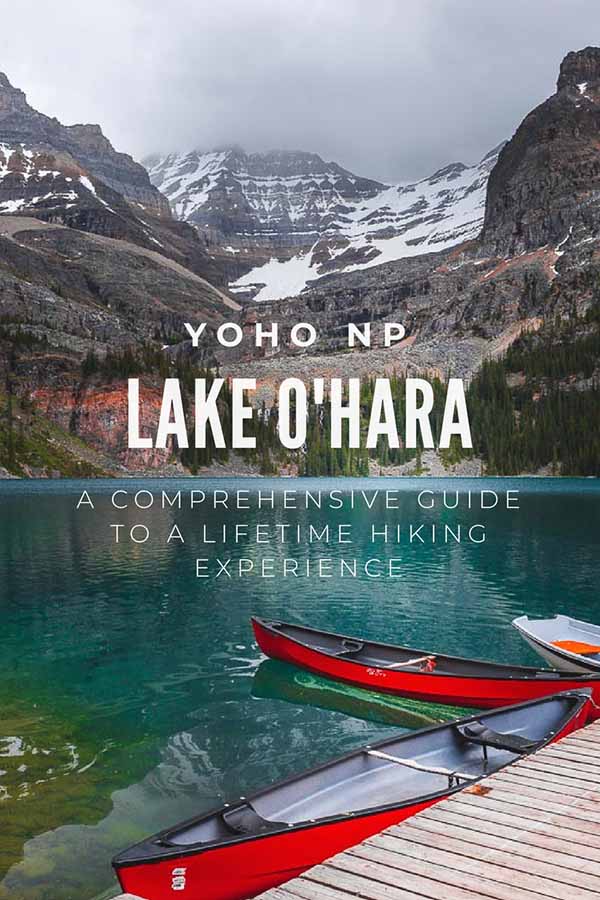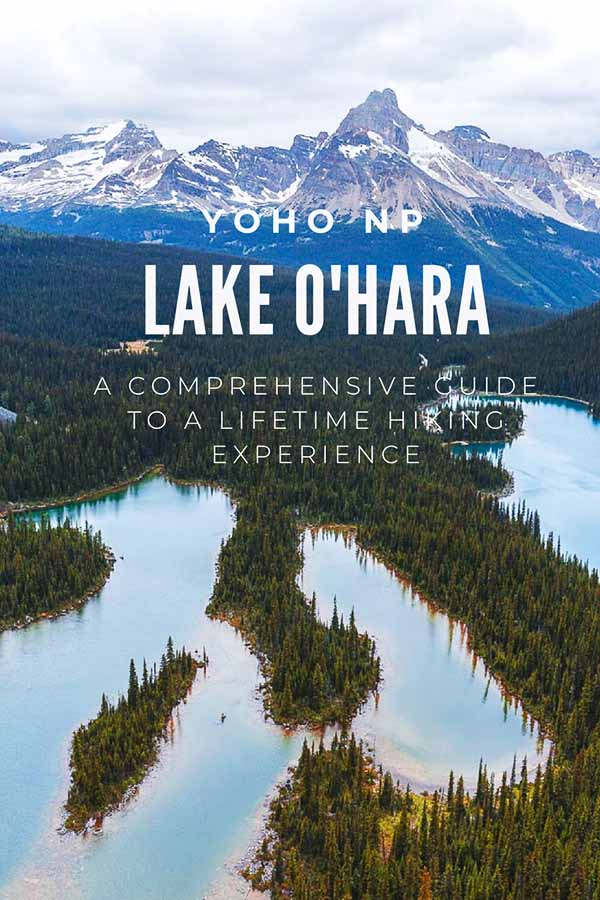A Complete Guide to Lake O'Hara
Lake O'Hara is one of the best backcountry hiking destinations in the Canadian Rockies. Read our detailed camping and hiking guide to Lake O'Hara in Yoho National Park in British Columbia. Including tips on making a shuttle bus and campsite reservation, when to visit, the best things to do, top places to see, trails, and where to find the best photo spots.
Lake O'Hara in Yoho National Park is one of the most sought-after hiking and camping destinations in the Canadian Rockies. Every year, when the reservation system opens up, thousands of avid hikers try to make the booking, and only a handful of them is successful and can start planning their Lake O'Hara trip.
We were lucky enough to make the reservation to the bus, which is often nicknamed the hardest bus to get on in British Columbia, and now we can share with you one of the best backcountry hiking experiences we've ever had.
You might be wondering whether this destination is not a bit overhyped; there are, after all, hundreds of beautiful lakes in the Canadian Rockies.
Even though it is certainly true, Lake O'Hara, in comparison, for example, with top destinations such as Moraine Lake or Lake Louise, has a few more aces up its sleeve.
First of all, it is the aura of a hard-to-get place that makes it popular, but it indeed would not have been enough. Secondly, it's the fact that Lake O'Hara is one of the best-preserved places in the Canadian Rockies.
Plus, the crystal clear lakes, hanging valleys, towering snow-capped mountains, designated and well-marked trails, fewer crowds, and the pristine nature that shows the best Yoho National Park has to offer.
These are several features of the area that should persuade you to include this area in your Canadian Rockies travel itinerary.
Although the main shining star, after which is the whole destination named is Lake O'Hara, there are many more things to see in this part of the park.
Based on our experience, we know that planning a camping and hiking trip to Lake O'Hara can be a daunting task as several actions need to be coordinated at once, from the accommodation, transport to practical things such as what to pack.
That's why we've put together a Lake O'Hara travel guide that includes everything you should know.
WHY VISIT LAKE O'HARA
Lake O'Hara is a unique lake in Yoho National Park in the province of British Columbia, Canada.
As the whole area of the Canadian Rockies is well-known for its crystal clear turquoise lakes and incredible snow-capped mountain peaks, you might wonder why particularly this lake receives that much attention and why it stands out among other destinations in Canada.
One of the reasons might be the hiking-friendly environment - with so many accessible trails starting right from the lake, hikers can easily spend days here without getting bored.
Also, the nature around Lake O'Hara is unique and fragile, and the Yoho National Park management works hard to preserve such an extraordinary place by a strict reservations system when only a limited number of interested people can visit the area daily.
Although we loved hiking in more popular places such as Jasper National Park or Banff National Park, Lake O'Hara's deserted trails blew us away.
Last but not least, the lake itself and the most famous Opabin Prospect viewpoint is just stunning and worth the effort.
If you plan to visit the Canadian Rockies, Lake O’Hara is definitely a place you should consider.
HOW TO GET TO LAKE O'HARA
Getting to Lake O'Hara is not that hard as it might seem at first, but your options are a bit limited because of the remote location and protection measures in place.
First of all, it is compulsory to mention that the area is available for both day-trippers and those who want to stay overnight either in a campsite or lodge.
We cannot keep other crucial information for ourselves because you need to know that Lake O'Hara cannot be accessed by car or bike, so you need to park on the Lake O'Hara parking lot that is just off Trans-Canada Highway, and from here, either walk or hop on a bus.
Lake O'Hara parking is about 200 kilometers (2 hours drive from Calgary), less than an hour drive from Banff, and we traveled from Johnston Canyon, which is only 46 kilometers away.
As you can see, the parking lot is easily accessible, but as there is no public transport, we highly recommend renting a car for your Canadian Rockies adventure.
In the paragraphs below, we'll talk more closely about both alternatives you have on how to get to Lake O'Hara.
HIKING ALONG THE LAKE O'HARA FIRE ROAD
Hiking is not the most common way to reach the lake, but it is good to know this alternative exists for those who are fit and couldn't make a shuttle bus reservation. What is the advantage of hiking to Lake O'Hara?
Most importantly, you can avoid the hassle of making the booking, and you do not have to stress out that you won't get to Lake O'Hara.
The disadvantage is that the distance between the parking lot and Lake O'Hara is 11 kilometers, and you'll walk on a gravel road through a thick forest which is not particularly exciting.
It means you'll spend 4-6 hours only to get in and out plus another 5-8 hours hiking in the Lake O'Hara area.
Walking out and back in one day is really doable only by fit and more experienced hikers. The path to the lake leads uphill and can be done in 2-3 hours, and plan at least the same amount of time for the way back as you will most likely be tired.
Of course, you can still book a campsite or lodge, so you can hike to the lake, spend the night(s) there, explore the area, and hike out, which makes more sense.
Another alternative is to hike to the lake and check out whether there is no seat on a bus available for the way back. Of course, you must consider the option the bus will be fully booked, and you'll have another 11 kilometers ahead of you.
SHUTTLE BUS
If you want to save time and energy as many other travelers, your only option to get to Lake O'Hara is by shuttle bus.
This possibility makes more sense, takes less effort (in a physical way), but is tricky to manage, and the success is by no means guaranteed.
You can make a bus reservation (nicknamed the hardest bus to get on in British Columbia) and arrive at the parking lot at a specific date and time, from where the bus leaves.
Within 30 minutes, you'll arrive in Lake O'Hara, where you are allowed either to spend one day and go back the same day, or you can stay for up to three nights in the campground.
As you can see, a shuttle bus is certainly an easier way how to reach this famous destination; the only problem is that there are only a few departures daily and seats are limited.
Below, you can find tips on how to make a shuttle bus reservation.
LAKE O'HARA SHUTTLE BUS RESERVATION
Every year when the booking system opens for the season, only a fraction of people interested in spending time in this unique area are able to secure their seats.
In numbers, about 17 000 hopeful mountain lovers try to book the bus to Lake O'Hara, but only about 1 000 succeeds.
We cannot describe how lucky we felt when we managed to make the reservation for an overnight stay. But let's have a look at how to make your Lake O'Hara reservation.
Unfortunately, no trick would guarantee you the seat on the bus. You need to act fast, have a stable internet connection, or be patient on the phone line, and you also need a bit of luck.
The Lake O'Hara bus runs mid-June through the end of September or early October and is bookable from late April for the next summer season - you can check the updated information at Parks Canada.
The bus goes four times a day to the lake: 8:30 AM, 10:30 AM, 3:30 PM, 5:30 PM (the last two departure times are available for overnight campers only, day-trippers need to book either 8:30 AM or 10:30 AM slot).
The return bus from Lake O'Hara to the parking lot goes five times a day at 9:30 AM, 11:30 AM, 2:30 PM, 4:30 PM, and 6:30 PM.
The reservation process itself is painful. You can either book the shuttle bus online through the outdated reservation system or call the Lake O'Hara Reservation Line.
The reservation process starts at 8 AM MTD time, and to be honest; we sat in front of our PC from 7:45 AM.
When the exact time has come, we immediately tried to make a reservation, but all dates available were suddenly red and fully booked.
We have no idea how it happened and how some people could book it before us, but we were left disappointed without seats. If you don't succeed, do not despair, though.
You cannot do anything else but wait if someone cancels, but it happens (it usually happens when the last-minute weather forecast is exceptionally poor), so keep checking the site daily.
Booking solely a shuttle bus is the option only if you plan a day trip. If you want to stay in the area overnight, things work a little bit differently. We were spying on campsites spots as well, and our patience has paid off.
If you plan on spending a night, the situation is very similar to booking a shuttle bus; you just need to secure a tent site; this site automatically comes with a seat on the bus.
The Lake O'Hara campground has only 30 sites that are often gone right away, and if you're not successful, you just need to check out the site or call regularly and hope someone will cancel and the spot will reopen.
The best option (that worked for us) was to call from time to time the Lake O'Hara Reservation Line.
Suppose you want to make the reservation for the campsite no matter if, via internet or phone, there are a few things you should have ready.
Make sure you know your preferred dates already (the maximum number of nights is three, so as many travelers as possible get to see the place), the number of camping spots you want to book (maximum is 2), the number of people on one camping spot (the maximum is 4), your preferred shuttle bus time, and you also need to have your credit card ready, because the payment is charged straightaway.
LAKE O'HARA SHUTTLE BUS COST
The Lake O'Hara bus costs $14.70 for roundtrip or $9.75 for an outgoing ride only. You also have to cover the reservation fee, which is $4.50 per ticket for 1 or 2 people when booking online or $6.25 per ticket when booking over the phone.
If you are traveling at a party of 3+ people, there is a flat reservation fee of $11 when booking online or $13.50 if booked by telephone.
All reservation fees are non-refundable.
UPDATE
From 2020, the reservation process for day-trippers who do not want to spend the night by Lake O'Hara changed. It nowadays works on a lottery basis. You can submit your application for $10 (the number of applications is not restricted).
Once you have your lottery ticket (you can book it online or via phone), select your preferred dates (up to 6), and then only wait whether you'll get lucky during the random draw process.
This system should give all travelers an equal chance, not only to those who are fast or persistent.
GOOD TO KNOW
We understand that some travelers might be desperate to get to Lake O'Hara, and new strategies how to secure the spot have been developed during the years.
If you do not want to spend in the area a night, but the bus is unavailable for day-trippers, the idea of booking a camping spot that comes with the bus seat might come across your mind.
You should know that rangers are aware that this was happening, and nowadays all people who booked the campsite but do not have a tent and camping gear with them are not allowed on the bus.
WHERE TO STAY IN LAKE O'HARA
You have several options where to spend a night in the Lake O'Hara area, and it only depends on your Canadian Rockies budget and the required level of comfort when it comes to the accommodation.
It is not allowed to spend the night outside designated areas, which leaves you with three options: Lake O'Hara Campground, Elizabeth Parker Hut, or Lake O'Hara Lodge.
CAMPING
Sleeping in the Lake O'Hara campground is the cheapest and the most unforgettable experience that gave us a chance to connect with nature. Spots are bookable only via phone or park's website three months in advance of your planned visit (the campground is open mid-June through the end of September).
You can stay here for a maximum of three nights, and a reservation is possible to make for up to two tents (1 per site).
This backcountry campground was one of the best we've ever stayed in.
It is well-organized, has a cooking shelter, clean toilets, bear lockers for each site, wood, and running potable water. You just need to bring your tent, sleeping mats, sleeping bag, food, and cooking gear.
The camping fee at Lake O'Hara is $9.80 per adult per night plus a return bus fee plus an $11.70 non-refundable reservation fee per party.
If you are looking for more information on camping, read our Camping in the Canadian Rockies Guide.
ELIZABETH PARKER HUT
Elizabeth Parker Hut is another option where to stay, the hut is open year-round, but the booking system is lottery-based in the summer season!
The lottery opens every fall, and the Alpine Club of Canada is the organization operating the service.
You can enter the lottery as many times as you want, each time, you must pay $10, and every time you must select the dates you are after and the required length of stay. The chance to stay in the hut is much higher in the winter than in the summer months.
The Elizabeth Parker Huts cost $35 per person per night for Alpine Club of Canada members or $45 per person per night for non-members.
Although the membership doesn't affect the chance to win, at least one member of the party (the one who is making the reservation) must be a member to be able to finish the reservation process. Once the winners get their confirmation, they can also book a shuttle to the lake via ACC.
The hut can sleep 20 people in the winter and 24 in the summer.
LAKE O'HARA LODGE
By no means, the most luxurious accommodation type in the area is Lake O'Hara Lodge. Situated on the lakeshore, the lodge offers stunning views, upscale accommodation considering you are in the wilderness, and great dining options.
Even though the rates are around $1000 per night, including meals, the lodge is very often fully booked by those who want to enjoy the incredible scenery and the comfort of high-end accommodation.
We usually are not travelers who spend that much money on a single night; to be honest, we consider it crazy to pay that much only to sleep inside.
Still, after we saw pictures of the lodge, we must admit that we were a little bit jealous when coming back to our tent.
WHAT TO SEE AND DO IN THE LAKE O'HARA
Lake O'Hara is a famous hiking area, and the number of trails offers a few ways to spend your time. The trails in the Lake O'Hara surroundings lie in the lake's actual proximity, and the views from above are hard to match.
You can either walk around the lake, hike demanding Alpine Circuit, which connects the most beautiful spots and viewpoints, or you can pick one or two places and climb from the lake directly to your point of interest.
All trails from the lake's shore are well-marked. In general, if you have only one night in the area and one full day, we would recommend you hiking the loop (it is also doable for very fit day-trippers).
If you have more days and want to explore the area more leisurely, choose one of the partial trails, such as Opabin Plateau or Lake Oesa.
LAKE O'HARA ALPINE CIRCUIT
We hiked the Lake O'Hara Alpine Circuit but did not make it to All Soul's Prospect as it was still snowbound in late June, and if we have walked the whole trek, we would've missed the outbound bus.
We've made a list of places that are unquestionably worth visiting, and if you follow the circuit, you'll be able to see them all.
THE WIWAXY GAP AND HUBER LEDGES
The trail up to Wiwaxy Gap is steep but not that long, and we got very soon above the tree line and were rewarded with incredible vistas.
The Wiwaxy Gap is the highest point of the Alpine Circuit, and we found it best to hike here first from the lake's shore when we were still full of energy.
Huber Ledges connects Wiwaxy Gap with Lake Oesa. It is a rocky and easy-to-follow trail, and it is for sure better to walk it down than in the other direction.
Rocks are very slippery when wet, so be cautious.
LAKE OESA
Lake Oesa is another beautiful lake that offers views of a wonderfully colored lake with majestic peaks behind.
From here, you are only a short distance from well-known Lake Louise and Plain of Six Glaciers Trail, located on the other side of the valley. It is incredible how different this place is.
Quiet, without crowds, it was just us, marmots and chipmunks.
THE YUKNESS LEDGES
The trail connects Lake Oesa with Opabin Plateau and offers excellent views while you'll be walking through scree and slippery snow sections and under The Yukness Ledges towering above.
Watch your steps and also look up to make sure no rocks are falling.
OPABIN PLATEAU
Opabin Lake is the main feature on the Opabin Plateau.
The Plateau is a hanging valley atop a rocky cliff above Lake O'Hara. It is also home to several smaller alpine lakes flowing down the valley with melting snow and creating waterfalls.
OPABIN PROSPECTS
Probably the most photographed place on the whole Lake O'Hara Circuit is called Opabin Prospects.
It is not well-marked, but from Opabin Plateau, take the Opabin Prospect route, and eventually, in about 15 minutes, you'll get there. Stand on the rocky outcrop and enjoy one of the greatest views in the Canadian Rockies featured on many marketing pamphlets.
The view of Lake O'Hara and adjacent Mary Lake will leave you speechless!
LAKE O'HARA LOOP
If you are looking for an undemanding walk and yet want to get a sense of the place, the Lake O'Hara Lower Circuit is a must.
An easy well-maintained trail encircles the lake, and you can enjoy the peaceful atmosphere, beautiful mountain peaks around, and waterfalls running down the slopes.
Travel Insurance
We never leave our home without travel insurance which is designed to help cover our expenses if something goes wrong during the trip.
World Nomads Travel Insurance has been designed by travelers for travelers to cover your trip essentials.
Travel smarter and safer!
BEST TIME TO VISIT LAKE O'HARA
Without any doubt, the best time to visit the Lake O'Hara area is in the summer season. Not only is the weather warmer (although some trails can be blocked by snow as late as in June) and more stable, but the shuttle bus runs from June till early October, the same as the campground.
So what should you do if you plan your trip outside these months?
Well, first, you need to consider if you're well-experienced and prepared for more challenging conditions as temperatures in winter in Canada often drop below zero and snow is plentiful. Then you need to consider logistics.
As the bus does not work outside the main season, you need to cover these 11 kilometers on foot, and as the campsite is closed, you must book the more expensive Elizabeth Parker Hut or Lake O'Hara Lodge that are open all-year-round.
As walking on the gravel road is not that exciting, it is better to wait for the first snow, so you can cross-country ski to the lake, or it is at least better to use snowshoes.
Obviously, in the winter season, activities such as hiking are replaced by cross-country skiing, alpine mountaineering, or snowshoeing.
WHAT TO PACK
Lake O'Hara's packing list differs if you plan on spending there a night at a campsite, in a lodge, or if you're a day-tripper. Below, you can find essential things we packed for hiking and camping in the area.
You are in a Bear Country, make sure you carry a bear spray for your safety. You can buy it in outdoor shops around Canadian Rockies; just don't be surprised to pay double the price.
Bear spray is a really must-have item, do not underestimate it as the tourist season coincides with berry season when bears are most active.
There is no electricity at the campsite, so bring a headlamp.
Yoho National Park gets a lot of rain. We wouldn't go hiking without a good rain jacket and we also always pack rain poncho as it works the best and we can also cover the daypack.
If you visit the area only on a day trip, you'll be fine with a daypack; otherwise, you also need a rucksack 45-55L.
Quality, waterproof, and broken-in hiking boots are essential to enjoy hiking in the Canadian Rockies.
Backcountry cooking can be a fun experience with the right tools, so bring a cooking set together with food; we have a good experience with dried food.
The only way to prepare your food and tea at the campsite is by using a portable cooking stove with gas cans.
Backcountry camping in the Canadian Rockies is an unforgettable experience; make sure you have proper gear and equipment, including a quality lightweight tent, sleeping bag, and sleeping mat.
Unlike in the Mount Assiniboine Provincial Park, the water in the Lake O'Hara area is drinkable, and to keep your plastic consumption low, pack a reusable water bottle.
If you want to be sure the water is clean for drinking, purchase SteriPen or water bottle with integrated filter that kills most of the bacteria.
For more information, you can read a more detailed all-season Canadian Rockies packing list.
ACCOMMODATION
As we've already mentioned, the Lake O'Hara parking lot is well-accessible, which means you can spend the night before or after hiking adventure in one of the towns within driving distance.
The majority of travelers usually spend the night either in Lake Louise, Golden, Banff, or Calgary, depending on the itinerary.
We've selected the best hotels in each location that you can consider as a base for visiting Lake O'Hara.
Lake Louise | Lake Louise Inn - Modern, efficiently designed with views of the surrounding mountains, it is one of the best hotels in one of the most touristy towns in the Rockies.
Golden | Best Western Mountainview Inn - Clean rooms, convenient location, air-conditioned rooms, and excellent breakfast is included. Golden is often considered an off-the-beaten-path town, but it is also fully booked in the season.
Banff | Banff Park Lodge - An environmentally friendly hotel located in the town center surrounded by stunning scenery.
Calgary | Aloft Calgary University - Modern and clean hotel close to Calgary's university is the right place for you if you like design hotels with great service.
Travel Resources
Here you can find links to all the travel resources we use and which you might find helpful when planning your next holiday.
Accommodation: When looking for accommodation, we usually search hotels via Booking.com or Hostelworld.
Tours: Although we love to travel independently, some places are better to visit with a guided tour.
We prefer GetYourGuide for its easy-to-use interface and solid reputation. Another great alternative is Viator.
Rental Cars: When going on a road trip, we always use Rentalcars.com, a reliable site for booking a rental car in advance.
Flight Tickets: When looking for flight tickets, you can search Skyscanner to find the best price.
Travel Insurance: World Nomads and SafetyWing cover against risks of travel.
